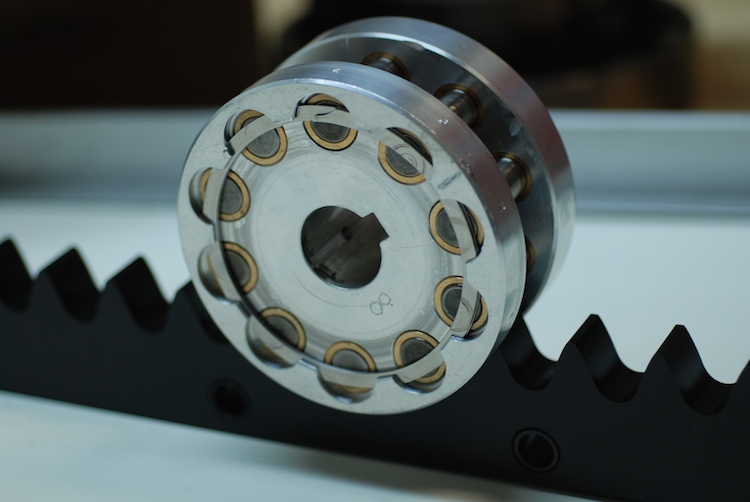
The latest generation
June 30, 2015
By David Hein Nexen Group
Thermoplastic racks open up new motion control applications

Jun. 30, 2015 – Rack and pinions are linear actuators that play a critical role in a wide range of linear motion control applications.
While rack and pinions are commonly thought of as a timeless technology, several new developments have helped provide significant performance improvements in specific applications. One new approach — the roller pinion system — replaces the traditional rack and pinion with bearing supported rollers, increasing positional accuracy, speed and durability. The latest development goes one step further by constructing the rack from thermoplastic, which provides corrosion resistance, eliminates the need for lubrication, and reduces weight and cost. The latest generation of rack and pinion gears helps adapt this tried-and-true technology for dusty environments, food industry applications that require washdown, outdoor equipment, and many other applications that are not well served by traditional metal gears.
Conventional metal rack and pinion systems
Conventional rack and pinion gears consist of a circular gear, called a pinion, that engages the teeth of a linear gear, called a rack, to convert rotational motion to linear motion. Rack and pinion gears are commonly used as linear actuators in a wide range of machinery. For example, they are used to move the axes of CNC machine tools, such as machining centres. They are also widely used to position robots used in assembly, welding, painting and other operations. Rack and pinion actuators are also suitable for controlling valves in pipeline transport applications.
Roller pinion systems
Traditional metal rack and pinion gears are less than ideal for many applications due to shortcomings such as backlash, cumulative error, thermal creep, vibration, noise, and particle emissions. A new design addresses these shortcomings by replacing the spur gear teeth with bearing supported rollers that engage a unique rack tooth profile. This approach replaces the sliding friction of conventional rack and pinion systems with smooth rolling friction that provides 99 per cent efficient rotary to linear motion conversion. Due to the smooth way the rollers engage the rack teeth, the new approach generates very low noise and vibration. It also does not suffer from noise caused by tooth slap or recirculating balls that can occur with other linear drive systems.
Characteristics of thermoplastic rack and pinion systems
Steel rack and pinion systems are ideally suited for clean operating environments, but applications involving corrosive fluids, washdown applications where the equipment is sprayed with water, outdoor applications, etc., are likely to substantially reduce the life of a metal rack and pinion. Most metal rack and pinion systems require lubrication, so they are not well suited to applications that generate considerable contaminants such as wood, fiberglass routing, or other applications that produce dust and debris.
Thermoplastic racks provide an alternative that delivers very high corrosion resistance, high durability and low maintenance requirements at a relatively low cost point. Thermoplastic racks are impervious to corrosion. They are made of a self-lubricating polymer so they can withstand dirty environments and outdoor operation without concern over failure due to the loss of lubricant. Their ability to run at full speed without lubrication reduces maintenance requirements and means that these systems can easily withstand washdown, outdoors operations, operation in coastal climates with salty air, etc. A related development is a new generation of value-oriented roller pinions that can also withstand dirty and harsh environments while providing good accuracy, good speed and good flexibility at an economical price point.
Typical applications for thermoplastic racks
There are many very high precision applications where steel racks will continue to provide the best fit such as CNC machine tools, waterjet cutting systems, and robot transfer applications. Many other applications are well suited for thermoplastic racks as well like CNC routers, and are generally used for cutting wood, composites and plastic. Routing operations generate large volumes of chips that can interfere with lubrication of steel racks. Thermoplastic racks provide a good fit in most cases because they do not require lubrication and provide sufficient accuracy. Material handling applications such as conveyors and picking systems typically require high durability and low maintenance, while high levels of accuracy are not. Thermoplastic racks provide a very good fit for this application, primarily because of their low maintenance requirements and low cost. They also provide a good fit for part marking systems, another application where low maintenance and durability are important but accuracy is not as critical. Many gantry-based automation systems are another good candidate for thermoplastic racks, as a typical gantry stacking system does not have high accuracy requirements so the low maintenance, durability and simplicity provide major benefits.
Conventional steel racks and pinions have been a mainstay of machine design for more than a century and are well positioned to maintain their leading role for many years to come. Yet there are many applications that can benefit from a simple and durable alternative that offers high levels of corrosion resistance, reduced maintenance requirements and lower cost, while still providing accuracy and are load bearing. Thermoplastic racks deliver all these benefits and are destined to play an ever-increasing role in the industrial machinery of the future.
David Hein is the vice-president of engineering for Nexen Group, where he has managed worldwide new product development for more than 10 years. He also serves on several non-profit advisory boards.
This article originally appeared in the June 2015 issue of Manufacturing AUTOMATION.